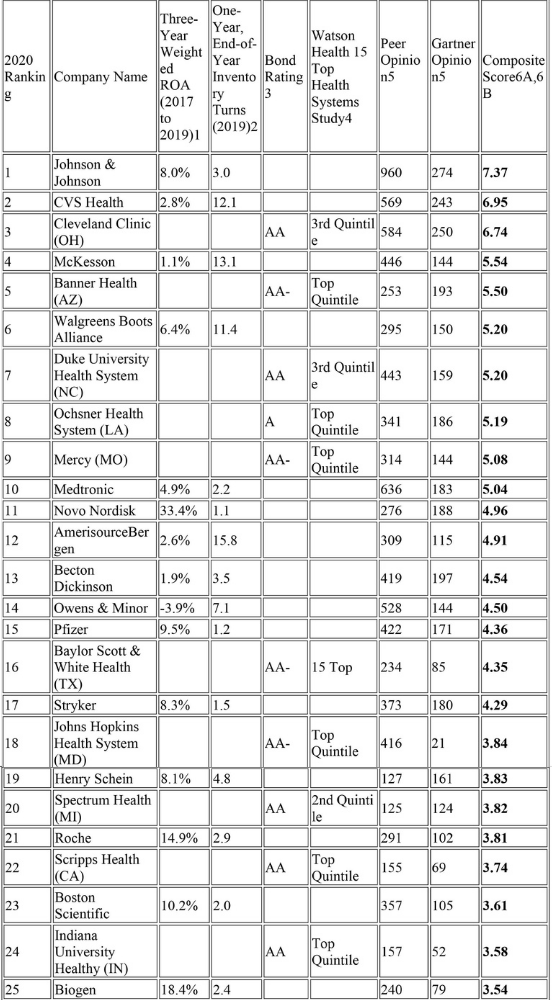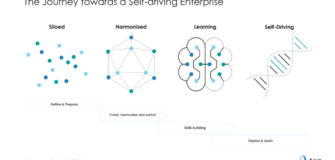Sitting at the top of the list is Johnson & Johnson, who was also in the No.1 slot last year, while four supply chain organisations make their debut in the 2020 ranking.
Gartner, Inc. has released its 12th annual Gartner Healthcare Supply Chain Top 25 ranking, which recognises companies across the healthcare value chain that advance healthcare by improving patient outcomes and controlling costs.
“2020 has proved to be a challenging year for healthcare and life sciences supply chains with the COVID-19 pandemic stressing many networks to their breaking point,” said Stephen Meyer, senior director analyst, Gartner Supply Chain practice.
“All supply chains had to make significant changes to the way they worked, both tactically and strategically,” said Meyer.
Johnson & Johnson (J&J) takes the top spot for the second year in a row, scoring the highest overall peer and Gartner opinion. CVS Health, Cleveland, McKesson and Banner Health complete the Top 5 (see Table 1).Four new organisations joined the ranking: Baylor Scott & White Health, Johns Hopkins Health System, Indiana University and Biogen.
In its third year, the Healthcare Supply Chain Top 25 Masters recognised sustained supply chain leadership in healthcare. The criteria were the same as in Gartner’s Global Supply Chain Top 25 – a top 5 composite score in any seven of the last 10 years. The Masters category is not a permanent appointment. Companies must requalify every year and continue to innovate.
“As with last year, Mayo Clinic, Intermountain Health Care and Cardinal Health defended their standing as Masters – a remarkable achievement for each of them. Even in this challenging year, they continued to demonstrate supply chain excellence, agility and innovation,” said Meyer.
Table 1. The Healthcare Supply Chain Top 25 for 2020

Notes:
1 ROA: ((2019 net income / 2019 total assets) * 50%) + ((2018 net income / 2018 total assets) * 30%) + ((2017 net income / 2017 total assets) * 20%)
2 Inventory Turns: 2019 cost of goods sold / 2019 inventory
3 Bond Rating: All ratings were mapped to the Standard & Poor’s (S&P) rating system using an industry-standard mapping system
4 Watson Health 15 Top Health Systems Study: Based on score in IBM Watson Health’s 2020 15 Top Health Systems Study
5 Peer Opinion and Gartner Opinion: Based on each group’s forced-rank ordering of performance to Gartner’s Healthcare Supply Chain Capabilities Model
6A Composite Score, Health Systems: (Peer Opinion * 35%) + (Gartner Opinion * 35%) + (Bond Rating * 15%) + (IBM Watson Score * 15%)
6B Composite Score, non-Health Systems: (Peer Opinion * 30%) + (Gartner Opinion * 30%) + (ROA * 20%) + (Inventory Turns * 20%)
2019 data used where available. Where unavailable, latest available full-year data used.
All raw data normalized to a 10-point scale prior to composite calculation.
Source: Gartner (November 2020)
COVID-19 as a Catalyst to Supply Chain Innovation
The COVID-19 pandemic is a fundamental challenge to supply and demand on a massive scale. Extreme demand swings stressed, and in some cases broke, supply chains — bringing into sharp focus what worked and what didn’t.
Leading supply chains leaders embraced the disruption as an opportunity to drive their supply chains further. They are adding new capabilities that will benefit not only their response to the pandemic, but also make their supply chains better once the world transitions to a new normal.
“Successful supply chains don’t focus on just one strategy, but a portfolio of elements and solutions to protect their supply chains, including classic risk management, demand and supply visibility and agility,” said Meyer.
In many countries, there was a fast pivot to telemedicine and home healthcare. Virtual care requires a unique response to address new demand patterns and leverage different fulfillment networks. For pharmaceutical companies this means potentially forgoing the classic wholesale relationship and building direct-to-patient capabilities and logistics networks. Several leading supply chains managed to quickly align their networks to the new realities and get patients the care they needed.
Another leadership trait that made supply chain leaders stand out in 2020 is the alignment of the supply chain function to the overall organisation’s strategy. Especially in the early days of the pandemic, ensuring that demand was fulfilled, and supply continued, took the full attention of the organisation.
“Leading supply chains ensure strategy development is directly linked to their company’s process. They align the supply chain strategy to the existing corporate goals, but also ensure company leadership understands how the supply chain can innovate to deliver additional company or customer value,” said Meyer.
He concluded that additionally, they seek external guidance from their customers and peers to include their perspective.
Source: Gartner Inc.



























































Follow us on social media